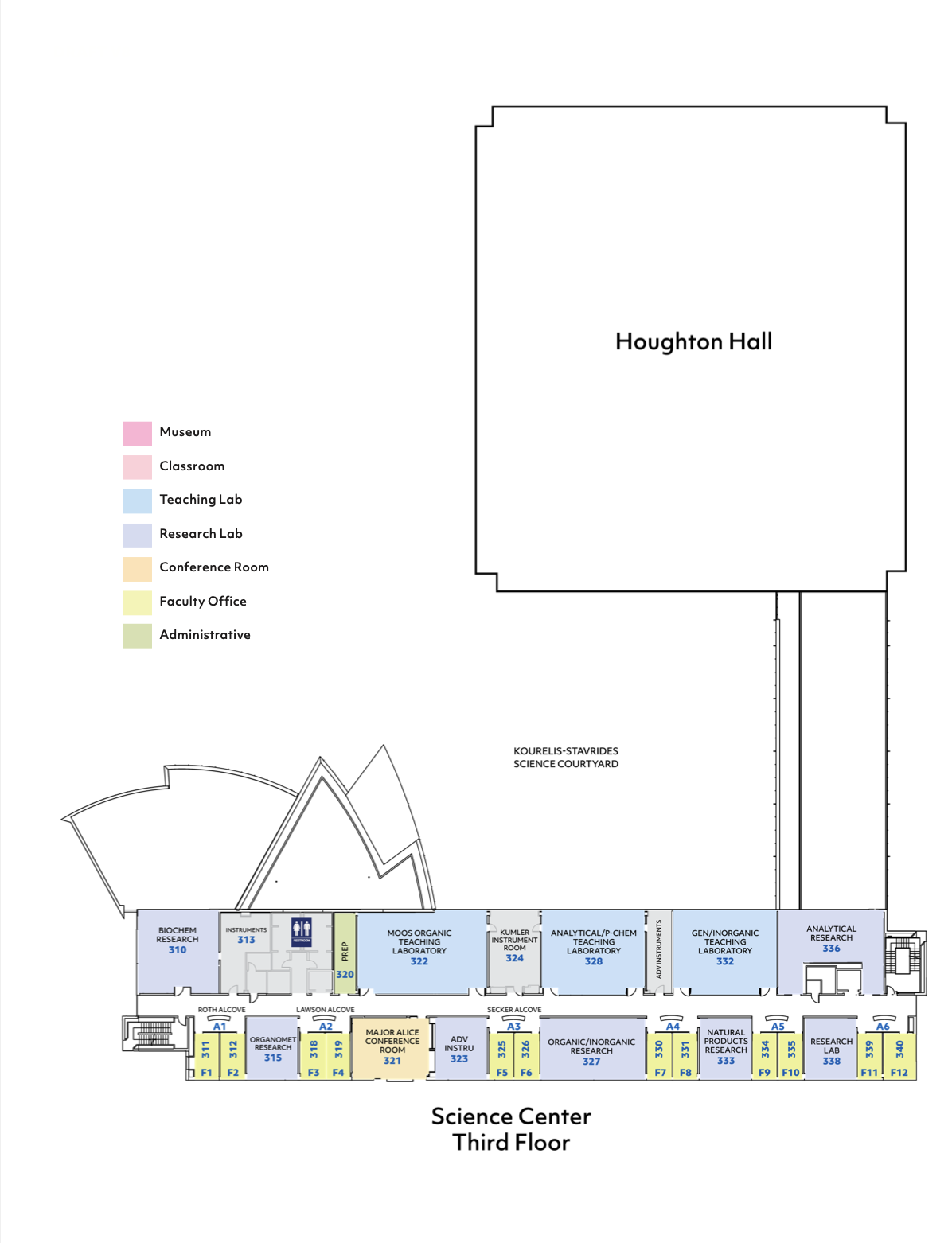Fredonia Science Complex - 3rd Floor Features & Naming Opportunities

Science Center, 3rd floor:
- 310) Biochemistry Research Suite: $40,000
Research in the biochemistry research suite focuses on the structure of biological macromolecules. High-Performance Liquid Chromatography (HPLC) equipment for purification and UV-Vis and fluorescence spectrometers for quantification and characterization of samples is used in conjunction with state-of-the-art NMR spectrometers to characterize the structure of both small and large biological macromolecules. The suite also has several molecular modeling work stations that enable faculty and students to determine the structure of biological macromolecules from NMR data and study ligand binding to nucleic acids and proteins. Collaborative projects are on-going with research groups at the University at Buffalo and Scripps Research Institute.
- 313) Biochemical Instrument Room: $100,000
Contains the LCMS, Maldi-TOF Mass Spectrometer, Fluorescence spectrometer, and Biospectrometer for nucleic acid analysis.
- 315) Organometallics Research Lab: $25,000
- 321) Major Alice Conference Room
Floor to ceiling glass wall overlooks the south garden and playing field. In memory of Major Alice M. Sam, USAF RET. and Adele R. Sam. Donated by Barbara A. Sam and Grace M. Sam.
- 322) Moos Organic Lab:
In this laboratory, students extensively use spectroscopic methods to identify different functional groups and the structures of organic compounds. Advanced labs involve the synthesis, isolation and characterization of organic compounds. Donated by Dr. Walter Moos and Dr. Susan Miller in memory of Walter’s father, Dr. Gilbert E. Moos, who taught Organic Chemistry for many years.
- 323) Janik X-Ray Diffractometer Lab:
This space is dedicated to High-Performance Gas Chromatography (HPGC), gas chromatography (GC), mass spectrometry and x-ray diffraction experiments. Donated by Dr. Christopher, ’93 and Mrs. Cathy Cahill. In honor of Dr. Thomas S. Janik.
- 324) Kumler Spectroscopic Instrument Room
This lab contains infrared and ultraviolet/visible spectrometers for the identification and quantification of chemicals. Donated by his former students in honor of Dr. Philip Kumler.
- 327) Synthetic Research Suite: $40,000
Students and faculty collaborate to synthesize and characterize novel inorganic, organometallic and organic molecules. Advanced air-sensitive technique are required for some of the syntheses and traditional separation procedures aid in product purification. New molecules are characterized by spectroscopic and x-ray diffraction studies.
- 328) Analytical/Physical Lab: $50,000
The Analytical Laboratory Courses rely heavily on the use of analytical instrumentation for the quantification, characterization and identification of chemical species; students get extensive experience utilizing chemical instrumentation. In the Physical Chemistry Laboratory course students engage in experiments that apply the laws of kinetics, thermodynamics, quantum mechanics and statistical thermodynamics to chemical systems.
- 330) Analytical Instrument Room: $5,000
The spectroscopic and chromatographic instrumentation in this lab supports the characterization of advanced synthesis, biochemical, physical and analytical experiments.
- 332) Inorganic/Advanced Experimental Biochemistry: $50,000
This laboratory is outfitted with the capability to perform inert-atmosphere inorganic and organometallic syntheses and analysis by spectral, solid-state and electrochemical methods. State of the art biochemical and molecular techniques are taught in Advanced Experimental Biochemistry including techniques such as polymerase chain reaction, oligonucleotide synthesis and gel electrophoresis.
- 333) Natural Products Research Lab: $25,000
- 336) Environmental Research Suite: $40,000
Research students are engaged in the isolation, purification and analysis of air and waterborne, semi-volatile organic and inorganic pollutants found in the Great Lakes area. Components, such as nitrate, sulfate, polyaromatic hydrocarbons (PAHs), PCBs, dioxins, and mercury are detected by Gas Chromatography Mass Spectrometry (GC-MS). This work is funded by NYSERDA and the EPA and is done in collaboration with researchers at Clarkson University and SUNY Oswego.
- 338) Research Lab: $25,000
Science Center, Study Alcoves:
- A4-A6: $5,000 each
In front of each office pair, alcove spaces for studying are furnished with benches and writing boards, allowing for informal teaching.
- A1) Roth Family Study Alcove
Donated by the Roth Family
- A2) Lawson Study Alcove
Donated by Drs. Holly and Jerry Lawson-Keister. In honor of Eleanor and William Lawson
- A3) Secker Study Alcove
Donated by Dr. Christopher and Cathy Cahill in memory of Robert Secker (Class of 1993).
Science Center, Faculty Offices:
- F1-F12: $10,000 each
Faculty offices are paired behind study alcoves and placed between teaching and research labs.

